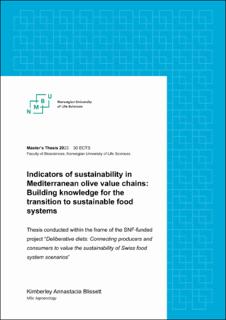| dc.description.abstract | The olive value chain is a cornerstone of the socio-cultural, economic, and environmental landscape of the Mediterranean region. The industry is a major source of employment and income in rural communities. In recent years, the sector has undergone significant shifts towards mechanized highly intensive cropping and irrigated systems. While there is an increase in profitability, the adverse effects on the environment and the socio-economic aspects of life have been noticeable, bringing into sharp focus issues of sustainability. Numerous studies have been conducted over the last decade to assess the sustainability of varying aspects of the value chain. The challenge is that there is no established mark, critical control point, or limit beyond which olive systems are deemed to be ‘unsustainable’ or a set of indicators that fully characterize the state of sustainability. This is largely due to the context-specific nature of sustainability and ongoing debates as to its meaning. This is further hampered by high heterogeneity in the sector. To identify a set of criteria and indicators that adequately addressed sustainability, satisfying both scientific rigor and value chain actors, a two-pronged bottom-up and top-down approach was used. A systematic literature review using the Preferred Reporting Items for Systematic Reviews and Meta-Analyses (PRISMA) guidelines was conducted in the region to identify indicators used in sustainability assessments along the value chain. Second, these indicators were compared to key sustainability criteria identified by farmers in the Andalusia region of southern Spain, based on separate research results from the Deliberative Diets project, using the Photovoice method. The literature review isolated 74 papers with 46% focusing solely on the environmental dimension of sustainability. The social and economic dimensions were largely neglected with 1% and 9%, respectively. Around 91% of studies were focused on the agricultural phase of the value chain. In contrast, the Photovoice action research revealed a predominant focus on social issues at the farm level with 41% of the criteria falling in the social dimension whereas only 20% and 9% addressed environmental and economic issues. A reconciliation of the criteria and indicator data sets provided a holistic view of sustainability issues and transformative pathways in the region.
Keywords: sustainability assessment, indicators, sustainability criteria, Mediterranean, olive | |
